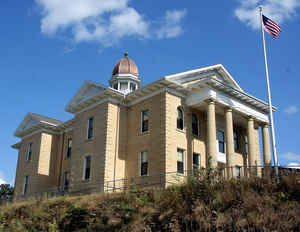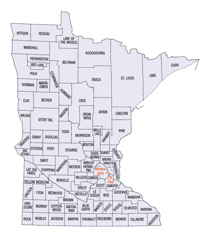Minnesota Counties
There are eighty-seven Counties in Minnesota. On October 27, 1849 nine large Minnesota Counties were created. Among them were Benton, Dahkotah, Itasca, Ramsey, Mahkahta, Pembina, Wabashaw, Washington, and Wahnata. Of those Benton, Dakota, Itasca, Ramsey, Wabasha, and Washington still exist as their original name. With the creation of Kittson County on March 9, 1878, Pembina County no longer existed. When Minnesota was organized as a state, 57 of the present 87 Counties were established. The last county to be created was Lake of the Woods County in 1923Dodge County, Minnesota
Dodge County Education, Geography, and History
Dodge County is a county located in the state of Minnesota. The population was 20,087 as of the 2010 census. Its county seat is
Mantorville.
Dodge County is part of the Rochester, MN Metropolitan Statistical Area.
Etymology - Origin of Dodge County Name
Named for Henry Dodge and his son Augustus. Henry Dodge, was territorial governor, delegate in Congress and US Senator from Wisconsin, 1836-57. Augustus Dodge was delegate to Congress for Iowa Territory, 1840-47 and US Senator from Iowa, 1848-55
Demographics:
County QuickFacts: CensusBureau Quick Facts
Dodge County History
Dodge County was originally inhabited by American Indians, as many counties in Minnesota were. This area was a common
hunting and battle ground for the Mdewakanton Sioux, often fighting the Sauk and Fox Indians who had wandered into their territory. The first
white person to visit Dodge County, however, is not known. It is believed by some that a French fur trader from Canada was the first, setting
foot on its soil in the spring of 1655. Guides deemed this area unsafe due to the Natives living there. But, it was not until over two hundred
years later that the locality truly came to life.
The original founders of Dodge County consisted entirely of settlers from New England. These people were "Yankee's", that is to say they were
descended from the English Puritans who settled New England in the 1600s. They were part of a wave of New England farmers who headed west into
what was then the wilds of the Northwest Territory during the early 1800s. Most of them arrived as a result of the completion of the Erie
Canal. When they arrived in what is now Dodge County there was nothing but a virgin forest and wild prairie, the New Englanders laid out
farms, constructed roads, erected government buildings and established post routes. They brought with them many of their Yankee New England
values, such as a passion for education, establishing many schools as well as staunch support for abolitionism. They were mostly members of
the Congregationalist Church though some were Episcopalian. Culturally Dodge County, like much of Minnesota would be culturally very
continuous with early New England culture, for most of its history. It was in 1853 that government surveyors set lines for the townships. A
year later, the Mantor brothers, along with Eli P. Waterman, established their claims, which would later be an important town to the area
known as "Mantorville." Still a year later, in 1855, Dodge County was organized for local government.
Geography: Land and Water
As reported by the Census Bureau, the county has a total area of 440 square miles (1,100 km2), of which 439 square miles (1,140 km2) is
land and 0.3 square miles (0.78 km2) (0.07%) is water.
Dodge County is located in the Southeastern part of Minnesota and spans 24 miles (39 km) long and 18 miles (29 km) wide. To the North and
center of the county, it is hilly, high, and rolling with pebbly, loose soil, laid with a considerable amount of timber. This makes it
well-suited for grain raising. The Southern part is quite the opposite. Being it is flat and wet, it's adapted perfectly for grazing and
raising stock. The soil in this area is excellent for yielding huge crops, considering its extremely fertile soil. The heavy, black, clay loam
makes this area a prime location for agriculture. Dodge is one of seven southern Minnesota counties that have no forest ecosystems; only
prairie and savanna soils exist here.
Dodge County's plentiful amount of sand and rock also make the area a center for building. Quarries in Mantorville were once enterprises and
consist of layers of thick stone which can be cut into any desired shape. Wasioja is also known around the nation for its excellent "Wasioja
stone."
Neighboring Counties
Bordering counties are as follows:
- Rice County (northwest)
- Goodhue County (northeast)
- Olmsted County (east)
- Mower County (south)
- Steele County (west)
Education







